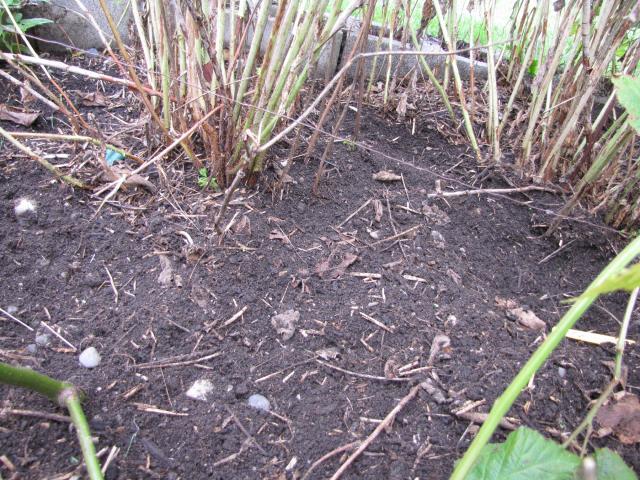Why I Use Straw
I see questions come up every so often about the best litter or bedding to use in a coop or a run. I think the best choice depends largely on what you needs are and what your set-up entails. I want to explain why I've decided to use straw.
To start, wood shavings and straw are the most available and reasonable priced bedding options for me in my area, so I considered both. Also, my run and my coop occupy the same space. Our mild climate requires only that I keep them dry, so my entire coop/run area is entirely covered to protect the birds and the litter from rain. This is an picture of the coop before it was finished, the panels now come down nearly to the ground and we throw on a tarp all winter to ensure no rain gets in.

As far as I can tell, my chickens provide me with enough eggs that I break even on the basis of how much I feed them. To retain their waste and litter would be another way of recouping the expense of keeping them. I wanted to compost and retain their waste as rich fertilizer for my garden. I also wanted it to break down fairly quickly. I get more than 350 inches of rain every year, I've been told that's nearly a million gallons of water washing through my soil every year. In addition, my soil is basically a sand pit, there is nearly no top soil. Ammending my soil routinely is a must if I am to succeed as a gardener. So I sheet compost. The larger part of composting is not just enriching the soil, it's building the colonies of microorganisms that rapidly process raw materials in your garden into a form that plants can use. So I think of the soil in my garden as a living organism that has a symbiotic relationship with my plants. Feed the soil, feed your plants.
Lets talk about carbon and nitrogen. I own both of Steve Solomon's books, Growing Vegetables West of the Cascades and Gardening When it Counts (which I very highly recommend). He provides a very good explaination of carbon to nitrogen ratios and why they are essential to creating rich compost and healthy soil. In every climate and every soil, humus has a carbon/nitrogen ratio of 12:1. Anything you add to your soil that has a higher C/N ratio than that basic standard, the microbes will "burn" their carbon for fuel while preserving the nitrogen until the C/N ration is lowered to match that of the surrounding soil. This process will results in a higher level of humus, nutrients in the material will now be available to your plants, the texture of the soil will be improved and your soil will be healthier. This is the process that creates topsoil. The more carbon that is available in the ratio, the longer it takes to break down.
If you add material with a C/N ration that is lower than 12:1, the opposite happens. The nitrogen will be consumed and converted to ammonia untill the ratio is balanced. The ammonia is then converted to nitrates, a fertilizer that makes plants grow FAST. But it also makes the microbes grow fast and they begin to consume your humus. In large quantities, the end result is a soil that is lower in quality and organic matter. This is a process that depleats topsoil. Too much or too little of anything is usually bad in biological system that is striving for balance.
SO, Chicken manure has a C/N ratio of 6:1. If I add it to my garden now, I'm going to invoke the opposite of my desired outcome because I've added nitrogen and carbon in a ration that is lower than what already exists in my soil. My plants will grow quickly now , but the quality of my soil will be reduced in the long run. SO, I need to add more carbon to feed the microbes. Straw has a ratio of 50:1, which may seem high, but wood shavings have a ratio of 500:1. It will take wood shaving much longer to break down. By the time the second pile is ready for the garden to ration closer to half of what I started with. By the end of the year, my compost will be topsoil.
Compost pile generates some heat (depending on a lot of other factors) which helps to destroy pathogens before they make their way into my garden. The time spent without a host also kills pathogens. They will exist in my garden in any case, but anything I can do to reduce their numbers is in my best interest. You should wash everything you eat from your garden regardless.
So all that aside, this is a pic of my dry run even though it been raining constantly pretty much all week. This really helps keep the flies down and helps prevent disease in my birds. You can see there is a pile of fresh manure under the tall roost. That will be moved to what I call the first pile along with whatever straw is sticking to it. I'll put down another handfull of straw.

This is the first pile:

In several months, it will look like this. This is the second pile, which really isn't looking very pile-like anymore.

Pile 2 goes into the garden in the fall and the chickens spread it around for me as they dine on garden leftovers. This is the only time of the year they free range. Chicken manure also has plenty of calcium in it that plants like tomatoes need to fight disease. In the spring it turn it all under again before I plant. The combination of chicken manure and straw is well suited to good compost that will enrich your soil in a reasonable amount of time. If you have access to them, other good choices would include dried grass (as opposed to fresh, wet, green grass), dried garden weeds, dried tree leaves, dried legume hulls, hay.

This is the soil in another patch of my garden. I placed a load of manure and straw compost here the year before. It's become rich soil, with a few specks of straw that are still breaking down.

I see questions come up every so often about the best litter or bedding to use in a coop or a run. I think the best choice depends largely on what you needs are and what your set-up entails. I want to explain why I've decided to use straw.
To start, wood shavings and straw are the most available and reasonable priced bedding options for me in my area, so I considered both. Also, my run and my coop occupy the same space. Our mild climate requires only that I keep them dry, so my entire coop/run area is entirely covered to protect the birds and the litter from rain. This is an picture of the coop before it was finished, the panels now come down nearly to the ground and we throw on a tarp all winter to ensure no rain gets in.
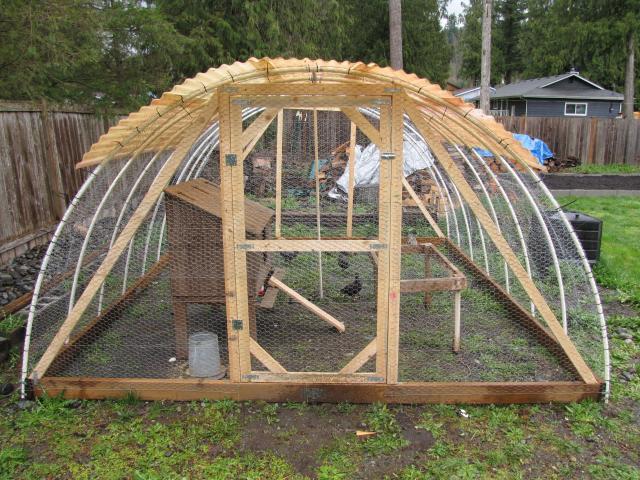
As far as I can tell, my chickens provide me with enough eggs that I break even on the basis of how much I feed them. To retain their waste and litter would be another way of recouping the expense of keeping them. I wanted to compost and retain their waste as rich fertilizer for my garden. I also wanted it to break down fairly quickly. I get more than 350 inches of rain every year, I've been told that's nearly a million gallons of water washing through my soil every year. In addition, my soil is basically a sand pit, there is nearly no top soil. Ammending my soil routinely is a must if I am to succeed as a gardener. So I sheet compost. The larger part of composting is not just enriching the soil, it's building the colonies of microorganisms that rapidly process raw materials in your garden into a form that plants can use. So I think of the soil in my garden as a living organism that has a symbiotic relationship with my plants. Feed the soil, feed your plants.
Lets talk about carbon and nitrogen. I own both of Steve Solomon's books, Growing Vegetables West of the Cascades and Gardening When it Counts (which I very highly recommend). He provides a very good explaination of carbon to nitrogen ratios and why they are essential to creating rich compost and healthy soil. In every climate and every soil, humus has a carbon/nitrogen ratio of 12:1. Anything you add to your soil that has a higher C/N ratio than that basic standard, the microbes will "burn" their carbon for fuel while preserving the nitrogen until the C/N ration is lowered to match that of the surrounding soil. This process will results in a higher level of humus, nutrients in the material will now be available to your plants, the texture of the soil will be improved and your soil will be healthier. This is the process that creates topsoil. The more carbon that is available in the ratio, the longer it takes to break down.
If you add material with a C/N ration that is lower than 12:1, the opposite happens. The nitrogen will be consumed and converted to ammonia untill the ratio is balanced. The ammonia is then converted to nitrates, a fertilizer that makes plants grow FAST. But it also makes the microbes grow fast and they begin to consume your humus. In large quantities, the end result is a soil that is lower in quality and organic matter. This is a process that depleats topsoil. Too much or too little of anything is usually bad in biological system that is striving for balance.
SO, Chicken manure has a C/N ratio of 6:1. If I add it to my garden now, I'm going to invoke the opposite of my desired outcome because I've added nitrogen and carbon in a ration that is lower than what already exists in my soil. My plants will grow quickly now , but the quality of my soil will be reduced in the long run. SO, I need to add more carbon to feed the microbes. Straw has a ratio of 50:1, which may seem high, but wood shavings have a ratio of 500:1. It will take wood shaving much longer to break down. By the time the second pile is ready for the garden to ration closer to half of what I started with. By the end of the year, my compost will be topsoil.
Compost pile generates some heat (depending on a lot of other factors) which helps to destroy pathogens before they make their way into my garden. The time spent without a host also kills pathogens. They will exist in my garden in any case, but anything I can do to reduce their numbers is in my best interest. You should wash everything you eat from your garden regardless.
So all that aside, this is a pic of my dry run even though it been raining constantly pretty much all week. This really helps keep the flies down and helps prevent disease in my birds. You can see there is a pile of fresh manure under the tall roost. That will be moved to what I call the first pile along with whatever straw is sticking to it. I'll put down another handfull of straw.
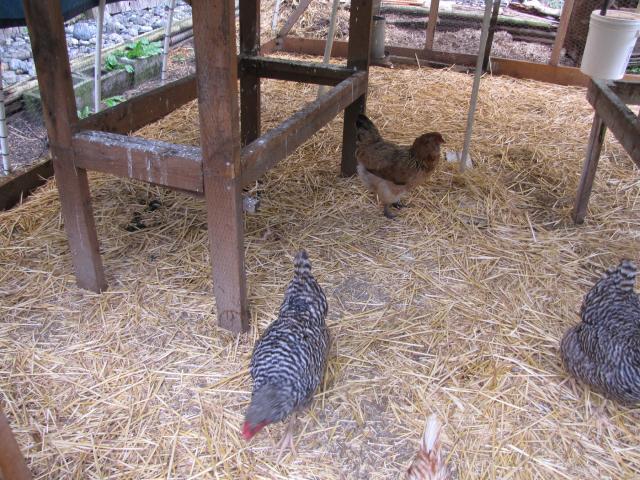
This is the first pile:
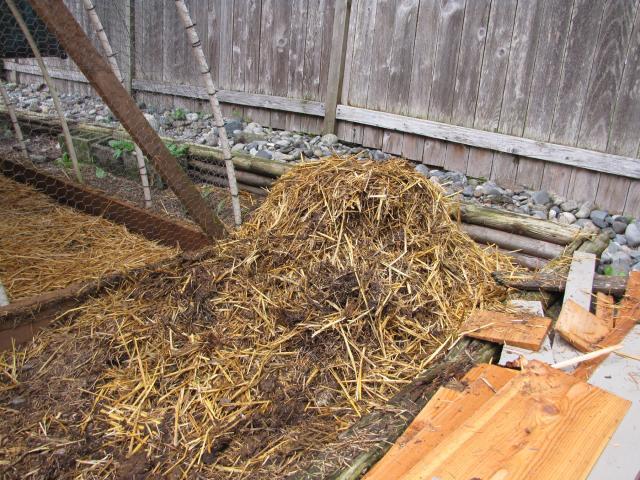
In several months, it will look like this. This is the second pile, which really isn't looking very pile-like anymore.
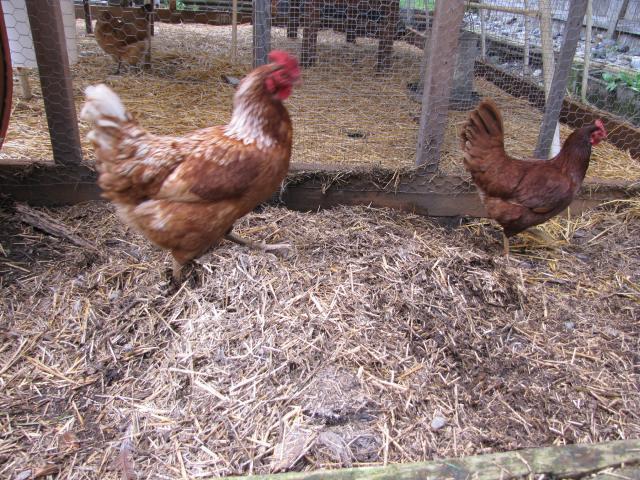
Pile 2 goes into the garden in the fall and the chickens spread it around for me as they dine on garden leftovers. This is the only time of the year they free range. Chicken manure also has plenty of calcium in it that plants like tomatoes need to fight disease. In the spring it turn it all under again before I plant. The combination of chicken manure and straw is well suited to good compost that will enrich your soil in a reasonable amount of time. If you have access to them, other good choices would include dried grass (as opposed to fresh, wet, green grass), dried garden weeds, dried tree leaves, dried legume hulls, hay.
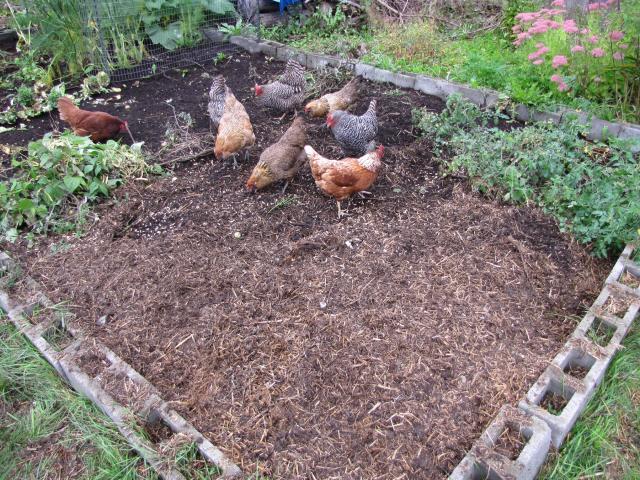
This is the soil in another patch of my garden. I placed a load of manure and straw compost here the year before. It's become rich soil, with a few specks of straw that are still breaking down.
